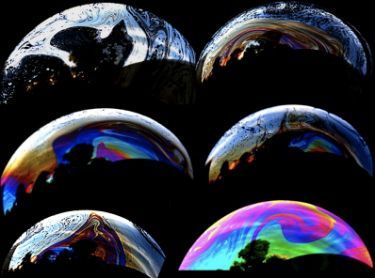A page from the "Causes of Color" exhibit...
Estimating bubble lifetimes

The principle of interference is responsible for the brilliant hues of certain butterflies and beetles, and is also seen in soap bubbles. In bubbles, thin film interference occurs.
A soap bubble is a very thin sheet of water sandwiched between two layers of soap molecules
Bubbles capture the essence of childlike wonder, perfectly formed, evanescent and rich with ephemeral color. They also demonstrate a plethora of useful scientific principles, including surface tension, ratios of surface area to volume, and interference colors.
What is a soap bubble?
A soap bubble is a very thin sheet of water sandwiched between two layers of soap molecules. The film of soapy water surrounds a bubble of air. Soap molecules have one end that repels water, and one that attracts it, and these molecules move to the inner and outer surfaces, thrusting their water-repelling ends out into the air, and their "heads" inwards. Without such molecules on the surface, the bubble would spontaneously break apart into tiny water droplets. Surface tension causes the bubble to be spherical, which is the shape that gives the minimum surface energy - the lowest ratio of surface area to volume.
Why are soap bubbles colored?
The thickness of the film - or rather, its thinness - determines whether iridescence is apparent. Light is reflected from both the inner and outer surface of the soap bubble.
When an incoming ray of light strikes the outer surface of a bubble, part of the light ray is reflected immediately, while the other part is transmitted into the soap film. After reaching the inner surface of the film, this transmitted light ray is reflected back toward the outer surface. When it leaves the bubble, it travels in the same direction as the ray that was immediately reflected and is, therefore, parallel to that ray.
If these two rays of light are reflected back so that their wavelengths are "out of phase" with each other, the second ray will partly cancel out the reflection of the first ray. This is called destructive interference, which results in a reduction of color intensity. If, however, the wavelengths of the two reflected rays are "in phase," they will enhance each other. This is called constructive interference.
The light rays that are reflected off the inner surface of the bubble travel further than the light rays that are reflected off the outer surface. Some wavelengths will interfere destructively and others constructively, depending on the extra distance traveled by a transmitted-and-reflected ray. Whether the reflected rays are in or out of phase with each other depends on the extra distance (through the film and back) that the second ray must travel before rejoining the first ray. This distance depends on the angle of the incident light and the thickness of the film.
White light is made up of different colors, corresponding to specific wavelengths. As the film thickness changes, the extra distance the ray must travel changes. Interference is constructive when the total extra distance matches a specific wavelength of light, and is destructive when it is half a wavelength. So if white light shines on a bubble, the film reflects light of a specific hue, and this hue changes with the film’s thickness.
The iridescence of a soap bubble, which seems to contain a wealth of changing color, stems from light striking the bubble from varied angles. The path length varies with the angle of incident light, giving varying path differences for the internally and externally reflected rays at different points on the bubble. This means that, even if the soap film is of uniform thickness, different colors can be seen. Light entering the bubble directly travels a shorter path than light entering at a wider angle. This allows different wavelengths to undergo constructive and destructive interference, so different colors are perceived.

David Stein holds the Guinness World Record for the longest bubble, over 15 m long.

Cluster of soap bubbles. A variety of beautiful colors appear in the swirls. Often, just before bursting, the swirls will appear black.
Changing color
The colors of a bubble are dependent on the thickness of the film. A bubble becomes thinner and thinner as it dries out (due to evaporation), before finally popping. As the surface film of the bubble becomes increasingly thinner, a change in overall color can be seen. Thick walls cancel out longer wavelengths in the red range. As the bubble film gets thinner, yellow wavelengths are cancelled out. As it gets even thinner, green light is lost. Beyond this point, even shorter wavelengths in the blue wavelength range disappear.
The resulting colors are a combination of the colors that do not undergo destructive interference and their degrees of constructive interference. Blue-green colors dominate in thicker films and yellow hues in thinner films. Eventually, the film becomes too thin to create interference of visible wavelengths, as all wavelengths are cancelled out. At this point the bubble appears colorless. Against a black background the bubble surface could appear black.







